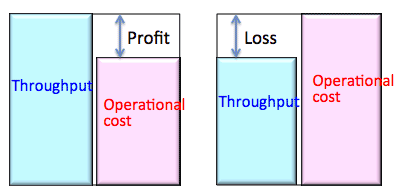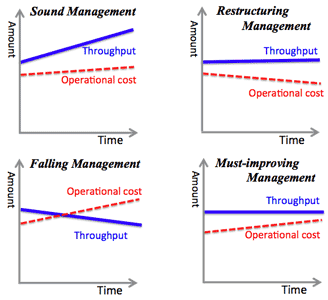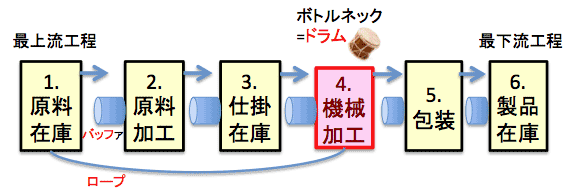 |
Cost-cut syndrome may deteriorate companies- How to lead to a profitable company -
|
Category: ECO |
Minekazu Homma (本間峰一) |
12331u/18209r |
Title
Cost cut policy may deteriorate the company
コストカットが会社をダメにする
Index
Tag
Standard hourly wage rate ; Snare of partial optimization ; Throughput (Added value) ; Cost-cut syndrome ; Theory of Constraints
Why?
- The author made a presentation at the workshop of ICTM-P (ICT Management Partners Association) at March 2012, which I participated as the original member.
- He is a seniro consultant of Mizuho Reseach Institute, who is also an expert of IT.
- His assertion of no-cost cut in rebuilding corporation seems a pardox; here is what he want to say.
- 著者は、ICT経営パートナーズ協会の勉強会(2012/3/21)で講演を行った。
- 彼はみずほ総合研究所の上級主任コンサルタントで、ITのエキスパートでもある。
- 彼のコストダウンが会社をダメにするという主張は矛盾に見える。ここに彼の主張のエッセンスがある。
English resume
Japanesse resume
>Top 0. Introduction:
- How to recover corporate profitability:
- to perform clear numerical control which the production site can manage.
- to set up clear policy and numerical target which may result in non-compromise situation on details after getting approval in general.
- to educate the basics of accounting, cost and expense, and profit mechanism to the related corporate staff who may not know in details or in essence.
0. 序:
- 収益性向上に向けた改善ポイント
- 現場が管理できる項目に絞った数値管理を行う。
- 総論賛成各論反対となりやすいテーマ故に、明確な基本方針の策定と目標数字の設定が必要
- 会計、原価、収益の基本を知らない企業人も多いのでわかりやすい啓蒙活動が必要
>Top 1. Outsource vs. Insource:
- Right corporate strategy:
- In recent years in Japan, many corporations, manufacturers in particular, are suffering destructive curtailment in production due to decrease of demand.
- to counter such situation, most of the manufactures tend to emphasize endless cost cut policy.
- It is essentially important for CEO to adopt right corporate strategy in the period of recession.
- Here is the case of consultancy how to rebuild manufacturing corporation.
- Outsourcing may cause further cost up factor:
- It is better to use internal resources which are even more expensive than outsourcing.
- The typical reasons to ask outsourcing:
- able to fill the gap which cannot fulfill internally.
- able to necessitate facility or technology which cannot avail internally.
- unable to prepare fixed resources (labor or facility) to meet fluctuating demand.
- able to ask outsource with cheaper budget than insource
- The above item 4. is the problem; why?
- They have compared their internal cost per hour (standard hourly wage rate) with outsourced cost per hour.
- But this comparison is not correct, because the internal cost is a tentative cost calculated by distributing internal fixed cost such as labor, overhead, or other indirect costs into tentative variable costs.
- The cost of outsource company is different.
- If they depend on frequent outsource, the company may deteriorate profit, leading to be unable to earn their fixed cost yet.
- Consider the case of housework; even the most cheapest homemaker services could not be cheaper than do-it-yourself.
1. 外注か内製か:
- 正しい戦略:
- 昨今、多くの企業、特に製造業が壊滅的な減産の状況
- 生き残るためには、終わりのないコストダウンが蔓延
- トップにとっては、不況な時こそ正しい経営戦略ととるべき。
- 以下製造業を再建させるコンサルの事例である。
- 外注会社を使うとコストアップになる
- 内製が外注より高くても内製をする方が良い。
- 外注会社を活用する主な理由
- 自社に不足の機能の補完
- 自社にない設備技術が必要
- 需要変動が激しく固定資産 (人、設備) を抱えておけない
- 自社より外注の方が安い
- 上記4.は問題。その理由は
- 社内単価 (時間賃率)と外注会社への発注単価を比較したら、後者の方が安かった。
- 但し、この比較は間違い。理由は、社内コストは、人件費、本社費用、間接費用など固定経費を人賃率に配賦して計算した仮の単価である、
- 外注への発注単価とは計算の仕方が違う。
- 外注ばかり使っていると、社内の固定経費分を補うだけの収入が確保できず、利益は落ち込む。
- 家事の場合と比較すると明白。自分で家事をする以上に安くなることはない。
>Top 2. Consolidated subsidiary and cost cut issue:
- There ia hierarchical relationship between parent company and affiliate company.
- Parent company tends to consider that affiliate company should be independent rather to live under the protection of parent company.
- And if unit price of outsourced company is cheaper than that of an affiliate company, the parent adopt the former offer.
- But this decision is incorrect, considering consolidated accounting.
- The most important thing of the consolidation is to improve the consolidated profit than to guide independence of the affiliate.
- Transfer of workers of the parent to the affiliate aiming cost cut of the parent.
- Direct labor cost of the transferred workers may decrease.
- But, the fixed overhead cost of the parent cannot be transferred to the affiliate.
- This mean the change of specific cost between the two companies; thus easy price discount due to this transfer should not be done to get our of continued deficits situation.
- Snare of shift to offshore production:
- Mass production in offshore, while high-mix and low-volume in domestic production
- Problems of domestic production.
- Cell production system is adopted in domestic factory.
- Stable profit had depended on mass production, which has shifted to offshore.
- Problems of offshore production:
- increase of logistic cost and administration cost.
- commitment to minimum production
- other risk factors
- Paradox of so-called visualization:
- standard hourly wage rate is calculated by the 'assumed sales volume', that is,
Cost reduction = standard hourly wage rate × cut-down working hours
- But if working hours have been cut, actual hourly wage rate becomes higher. (except over time fee and wage of temporary part-time worker)
- Later, the standard hourly wages must be adjusted.
- Real cost cut must be done as follows:
- to increase of production by shortened working hours.
- to fire the staff according to the shortened working hours.
- Snare of partial optimization:
- Even sales of negative earnings will be better than nothing:
- If it is assumed that there is such product with material cost is yen 10K and labor cost 10K: the marginal profit is 20K per piece.
- Could the sale of 18K per piece be acceptable?
- The answer is yes; because the income except the material cost will be 8K per piece.
- If the sales is unacceptable, such 8K will be null.
- TOC (Theory of constraints):
- proposed by Israeli physicist Eliyahu M. Goldratt in 1984 who is the author of 'The Goal'; emphasizing the three measures:
- increase throughput,
- decrease operational cost
- decrease inventory
 Throughput (Added value) = sales amount - externally purchased cost = operational cost + profit
Throughput (Added value) = sales amount - externally purchased cost = operational cost + profit - Here, externally purchased cost = material cost + subcontract cost
- Here, operational cost = labor cost + fixed operating cost (such as depreciation, interest, office cost, ad cost, expense account, etc.)
- The essence throughput management is that throughput should exceed operational cost.
2. 連結子会社とコスト削減:
- 親会社、子会社は暗黙の序列を持っている。
- 親会社には、子会社は親会社の庇護の下にあるのではなく、自立すべきという意見がある。
- 子会社の単価より外注会社の単価が安い場合、後者を優先的な活用する親会社がいる。
- 連結経営においてはこれは明らかな間違い。
- 連結経営で一番大事なことは、子会社の自立ではなく、連結決算の向上である。
- 親会社の作業員を子会社に転籍させることでコストダウンを図るケース
- 転籍によって作業員の直接労務コストは削減される。
- しかし作業員が転籍しても、親会社のオーバーヘッドの固定経費まで移る訳ではない。
- コストの明細が変わっただけなので、安易な値引きをすると赤字状態から抜け出せない。
- 海外生産シフトの罠:
- 大量生産を海外シフトし、多品種少量生産を国内生産する場合。
- 国内生産の課題:
- セル生産方式を採用
- 安定利益は大量生産に依存。それは海外移転した。
- 海外生産の課題:
- 物流コスト、管理コストの図化
- 最小生産へのコミットメント
- その他リスク要因
- いわゆる見える化の矛盾:
- 時間賃率は、想定売上に基づいて計算される。即ち
コスト削減額=標準時間賃率×作業短縮時間
- しかし、作業時間が減るとその分の時間賃率は高くなる (但し残業代やパート代を除く)
- 後に、標準賃率は精算される。
- 真のコストダウンのためには
- 短縮した作業時間で生産量を増やすか
- 短縮時間に見合う人員を解雇する
- 部分最適の罠:
- 赤字受注でもないよりは良い
- 材料費が1万円で、労賃が1万円の製品を作ると想定する。1個当たりの限界コストは2万円。
- では1.8万円/個で受注すべきか?
- 答えはイエス。理由は原料費を除いて8千円/個の収入があるから。
- もし売上げがなければ、この8千円も入らない。
- 制約理論 (TOC):
- イスラエルのEliyahu M. Golrattが1984年に提唱。"Goal"を出版。
- スループットを増やす
- 作業経費を減らす
- 在庫を減らす
- スループット(付加価値)=売価ー外部購入費=作業経費+利益
- ここで外部購入費=材料費+外注費
- ここで作業経費=人件費、固定経費 (減価償却、金利、事務所費、広告宣伝費、交際費等)
>Top 3. Throughput Management:
 Trend of throughput and operational cost:
Trend of throughput and operational cost:
- There are four trends of throughput and operation cost.
- Restructuring Management type should be a kind of emergency escape.
- It is the task of consultant to respond to either 'Falling Management', or Must-improving Management.''
- Throughput management is to manage profit, in fine.
- But corporate profit is the bottom line which is difficult to analyze.
- It is useful to observe the balance of throughput and operational cost in order to trace the real profitability.
- Some companies give more weight to sales volume, which may cause easy price cutting in sales, or purchase of stock and instant resale to increase apparent sales.
- How to increase throughput:
- either increase sales or decrease operational cost; the former is responsibility of sales division, while the latter manufacturing division.
- to increase sales:
- to sell more volume, or sell at higher cost.
- to avoid 'bargaining syndrome'
- to decrease operational cost:
- to clarify cost budget in short or long term.
- to decrease external purchase cost:
- to promote self-manufacture
- to decrease purchasing cost
- to procure at lower cost
- to prevent production neck.
- Kaizen, JIT, 5S, IE (Industrial Engineering), TQC, TOC, ECR (Efficient Consumer Response)
3. スループット管理:
- スループットと作業経費のトレンド:<左図>
- 4つのトレンドがある。
- 2番目のリストラ経営タイプは、緊急避難的
- 3番目の経営破綻タイプと要経営改善タイプはコンサルタントの役割
- スループット管理は結局、利益を管理することなる。
- 但し、企業の利益は、最終結果であり、分析は複雑
- そこでスループットと作業経費のバランスを見ることで利益を追跡できる。
- 一部企業では売上高を重視しているが、これは安易な値引き販売や、仕入・転売で見掛けの売上を増やすことになりかねない。
- いかにスループットを増やすか
- 売上を増やすか、作業経費を減らすこと。全社は営業部門、後者は製造部門の責任
- 売上を増やすには
- 販売量を増やすか、高く売る
- 安売症候群を避ける
- 作業経費を減らすには
- 短期長期での経費予算の明確化
- 外部調達費を減らすには
- 内製を推進する
- 調達コストを下げる
- より安く調達する
- 生産ネックの解消
- カイゼン、JIT、5S、IE、TQC、TOC、ECRなど推進
>Top 4. Cost-cut syndrome:
- Corruption of corporate governance reported:
- In 2007, lots of illicit activities by some companies were reported:
- used different materials described on the label.
- reused the labels of use-by date.
- manipulated inspection data
- These misconducts were reported repeatedly, which caused great loss or bankruptcy of such companies.
- These are the cases of moral hazard; more server internal control is urged to prevent such misconducts.
- Cost down syndrome:
- this is the case of companies which caused profit decline notwithstanding their earnest cost-cut or profit increase activities.
- Recent top management are eager to promote cost-cut activities.
- regarding the cost-cut is the essence of corporate management
- ban of order acceptance at lower profit, less workers by restructuring, relentless request of cost-cut to subcontractors, offshore production at lower-wage cost counties, thoroughness of internal cost-cut movement, etc.
- many labors feel significant stress from these cycles of cost-cut pressure.
- Could these cost-cut activities be effective - which really lead to profitability?
- there may be some effective cost-cut activities, but:
- corporate profit might decrease due to these activities.
- there are surely ineffective, or wrong cost-cut activities.
- Why?
- In Japanese companies, there are not a few top management who could not understand strict meaning of cost, profit, or deficit. They tend to mange based of vague impression of meaning of these terms.
- If this trend continues, corporate management must depend on accidental fortune or misfortune.
- Definition of 'cost' targeted by such cost-cut activities is ambiguous.
- concept of cost may changeable according to the ways of calculation
- in addition, relationship of cost and profit is changeable on a case-by-case basis.
- If you want to pursue profit improvement by cost-cut activities, then:
- clarify the relationship of cost and profit which you target to act.
- otherwise, even cost-cut activities may result in profit decline.
4. コストダウン症候群:
- 企業の不正
- 2007年に続出した企業の偽装問題
- コストダウンのために表示と違う材料を使用
- コストダウンのために消費期限切れの商品を再利用
- 検査データをごまかした。
- こうした不正がマスコミから繰り返し報道された。その結果、大幅減収状態となり、赤字転落もしくは倒産に追いこまれた
- 企業が不正に手を染めるというのは、突き詰めれば経営者のモラルの問題であり、企業の内部統制が重視されるにつれ改善されていかねばならない。
- コストダウンシンドローム(症候群)
- 経営者の指示によって現場でコストダウン活動や利益確保活動を熱心に展開したにもかかわらず、儲かるどころか会社が減益になってしまったという話
- 最近の企業経営者はコストダウンに非常に熱心
- 企業経営の基本はコストダウンにありとしてコストダウンを強要
- 低利益受注の禁止、リストラによる人員削減、取引先への理不尽な値引き要求、低賃金国での生産、重箱の隅をつついたようなコスト管理の徹底など、現場に様々なコストダウン活動を要求
- 度重なるコストダウン・プレッシャーに対して、心理的なストレスを感じている方も多い。
- コストダウン活動を推進することで利益は上がるか
- 収益性向上に効果のあるコストダウン活動もあるが、熱心にコストダウン活動に取り組めば取り組むほどかえって利益が減少するコストダウン活動というものも存在する。
- 誤ったコストダウン活動はかえって利益を得られなくする可能性がある。
- その原因のひとつ
- 日本の企業社会にはコストや利益、さらには黒字、赤字という言葉の厳密な意味を理解しないままに感覚的な印象で経営管理をしようとする経営者や管理者が多い。
- この状態を放置したままだと、たまたま運がよければ儲かり、運が悪ければ赤字になるといった経営を繰り返すだけ。
- そもそもコストダウン活動がターゲットとするコストはあいまい。
- コスト(原価)の計算結果は計算の仕方によっていくらでもかわってくる。
- しかも、コストと企業利益との関係はケースバイケースで様々に変化する。
- コストダウン活動の目的を収益性向上に求めるのであれば
- ターゲットとするコストと利益の関係を整理しておくことが必要だ。
- そうでないと、せっかくコストダウンしたはずが減益になってしまうといったことが起こりうる。
>Top 5. Re: "Theory of Constraints" of Eliyahu M. Goldratt:
- Proposed by Eliyahu M. Goldratt, Israeli physicist
- Published: "Critical Chain" (1997) , extended to TOC in 1999
- The weakest link in the process:
- "A chain is no stronger than it weakest link." ( Murphy's Law)
- Any manageable system is limited in achieving its goals by a very small number of constraints.
- Organizations can be measured by the followings:
- throughput; which is generating rate of money through sales. (Output)
- operational expense: all the money the company spends to turn inventory into throughput. (Friction)
- inventory; all the money the company invests with the intention to sell. (Input)
- Five focusing steps:
Process Of Ongoing Improvement (POOGI)
- Identify the constraint
- Decide how to exploit the constraint
- Subordinate all other processes to above decision
- Elevate the constraint
- If the constraint has moved, return to Step1.
- Type of internal constraints:
- Equipment: lack of capability of enough production
- People: lack of skill
- Policy: poor policy prevents the system
- The constraints is the thing that is preventing the organization from getting more throughput.
- Buffers: (=time buffers) ; Buffer management
- Buffers before the constraint: ensuring that the constraint is never starved.
- Buffers behind the constraint: preventing downstream failure to block the constraint's output.
- (Prerequisite) with one constraint in the system, all other parts of the system must have sufficient capacity to keep up with the work at the constraint and to catch up if time was lost.
- visual system of buffers: designating the buffer in three colors; green (okay), yellow (caution), and red (action requires)
- DBR: Drum-Buffer-Rope methodology:
- Drum (=Constraint): the physical constraint of the system. The rest parts of the system follows the beat of the drum.
- Buffer time : protects the drum, so that it always has work flowing to it.
- Rope; Putting work into the system earlier than this buffer time is likely generate too-high work-in-process and slow down the entire system.
(Picutre source: Goal-system consulting 2004)

5. <参考> エリヤフ・ゴールドラットの"制約の理論":
- イスラエルの物理学者E. ゴールドラットが提唱
- Critical Chainを発表(1997)、1999に制約の理論に発展。
- プロセスの最も弱いつながり
- 鎖の強さは、最も弱いつながりがせいぜい
- 目標を達成するシステムは、極めて少数の制約によって制限される。
- 組織は以下によって測定される。
- スループット
- 操業経費
- 在庫
- 5段階ステップ:継続的改善のプロセス
- まず制約要因を特定
- その制約からいかに引き出すか
- 上記決定に他のすべてのプロセスを従属させる
- 制約のレベルを上げる
- 制約が移動したらステップ1へ
- 内部の制約のタイプ:
- 設備:十分な生産能力不足
- 人材:スキル不十分
- 政策:システムを損なう誤った政策
- 制約とは当該組織がもっとスループットを上げることを妨げるもの
- バッファー:バッファー管理
- 制約の前のバッファー:
- 制約の後のバッファー:
- (前提) システムには1つの制約。他のすべての部部は制約部分に追い付く十分な能力がある。
- バッファーの見える化あり。緑(OK)、黄(注意)、赤 (異常発生)
- DBR方法論:
- Drumとは:システムの物理的な制約。その他のシステムの部分はこのドラムビートに合わせる。
- Buffer timeとは:ドラムを支援し、それに従うようにワークする。
- Ropeとは:バッファー時間より早くシステムに投入しても、ドラムをせかせることになり、システム全体が遅れる。

- Throughput Accounnting:
- Throughput (TP)=Sales - 直接材料費
- Inventoryh (IV)=原材料在庫+仕掛在庫+製品在庫
- Operation Expense (OE)業務費用=在庫以外のすべての費用(直接・間接区別なし)
- 企業目的: TPの増大◎、IVの減少○、OEの減少△
- 現状ツリー(Current Reality Tree) →対立解消図 Conflice Resolution Diagram
- 社内Constraints(=Rope)の発見・支援→制約部分の集中・専念
- 網羅的TQCより、個別的TOCの改善→新たな競争力の持続
Comment
- Why the Japanese tend to use 'cost down' meaning 'cost cut.' Presumably, they consider 'cost' is invisible, and they hesitate to cut invisible thing.
- Similarly, they want to use 'cost up' meaning 'cost rise.'
- It's strange, or rather interesting to find such very common wording is different between Japanese and English.
- Similarly, the Japanese usually abbreviate 'case-by-case' meaning 'on a case-by-case basis.'
- なぜ日本では、cost cutのことをコストダウンと言うのだろうか。コストは見えないので、見えないモノを切るのは躊躇するからか。
- 同様に、cost riseのことをコストアップと言う。
- このように非常に一般的な用語も日英で異なるのは不思議であるし、興味深い。
- 同様に、日本人はよくケースバイケースというが、英語では"on a case-by-case basisである。
Title |
Cost cut policy may deteriorate the company | コストカットが会社をダメにする |
|---|---|---|
Index |
||
Tag |
Standard hourly wage rate ; Snare of partial optimization ; Throughput (Added value) ; Cost-cut syndrome ; Theory of Constraints |
|
Why? |
|
|
English resume |
Japanesse resume |
>Top 0. Introduction:
|
0. 序:
|
>Top 1. Outsource vs. Insource:
|
1. 外注か内製か:
|
>Top 2. Consolidated subsidiary and cost cut issue:
|
2. 連結子会社とコスト削減:
|
>Top 3. Throughput Management:
|
3. スループット管理:
|
>Top 4. Cost-cut syndrome:
|
4. コストダウン症候群:
|
>Top 5. Re: "Theory of Constraints" of Eliyahu M. Goldratt:
|
5. <参考> エリヤフ・ゴールドラットの"制約の理論":
|
|
|
Comment |
|
|